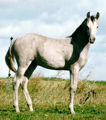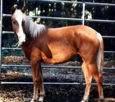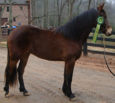|
|
Overview
- Due to the extensive number of horse breeds worldwide, the sample below includes those found in the UK and/or Europe. A Breed Society exists for most of the breeds listed below. A list of many of these societies can be found at http://www.worldofhorses.co.uk/Breeds/Breed_Society_List.htm
- Some of the breeds noted below come in a variety of colours. Where this is the case the picture is labelled with 'Various Colours'. Where possible the size of the horse has also been indicated.
Horses
- Error creating thumbnail: File missing
Selle Français
(Mainly Chestnut)
15.2-17hh
WikiCommons
Horses (Cold-Blood)
Horses (Hot-Blood)
Ponies
- Error creating thumbnail: File missing
Galiceño
(Any solid colour)
Up to 14hh
worldofhorses.co.uk
Other
Horse Passport
Horse Passports (England) Regulations 2004 require all owners to obtain a passport for each horse they own. This includes ponies, donkeys, and other equidae. Owners cannot sell, export, slaughter for human consumption, use for the purposes of competition or breeding, a horse which does not have a passport.^
For further information on filling out a Horse Passport, please see; http://www.horsepassportagency.co.uk
Standard Horse Colours
Principle Colours (Section A - Colours Commonly Occurring in Thoroughbreds):
- Bay : Reasonably clearly defined colour between black lower part of legs and the general tan/brown colour of upper legs and body. Mane and tail are black.
- Brown : Whole coat is brown and no distinguishing colour line between upper and lower leg.
- Black : Whole coat including legs, body, stifle fold and muzzle must be black. Any indication of tan in coat, stifle fold or muzzle should classify horse as brown.
- Chestnut : Coat is reddish or yellowish brown. Mane and tail are chestnut and may be lighter and darker than the body colour.
- Grey : Coat mixture of black and white hairs with black skin. With age coat will turn lighter but still termed grey. Majority of grey horses not grey as foals and should be described by predominant colour at the time but any white hairs should be noted in narrative.
- Roan : Body colour mixture of white, brown or chestnut and intensity variable seasonally. Although acceptable, Roan is rare in Thoroughbreds as most are actually in transition to grey. Roan examples are within the 'Other Colours' section.
Other Colours (Section B - Acceptable Colours not commonly occuring in Thoroughbreds):
- Blue Roan : Body colour black or black-brown with any mixture of white hairs giving blue tinge. Black hairs usually predominate on head and from knee or hock down. Some white limb markings also may occur.
- Red Roan : Body colour is bay or bay-brown with any mixture of white hairs giving reddish tinge to coat. Bay hairs usually predominate head. From knees or hock below black usually predominates although white markings may occur.
- Strawberry or Chestnut Roan : Body colour is chestnut with any mixture of white hairs. Chestnut usually predominates head and below knees or hock. White markings may be encountered.
- Blue Dun : Body colour between slate grey to light stone and always evenly distributed. Mane and tail are black. May or may not be dorsal stripe along back and/or withers. Skin is black.
- Yellow Dun : Diffuse yellow pigment in hair. May or may not be dorsal stripe along back and/or withers and bars on legs. Striping usually associated with black pigment on head and limbs. Black skin.
- Cream : Body colour is cream with unpigmented skin. Iris is deficient in pigment giving eye pinkish or bluish appearance.
- Piebald : Body colour has large irregular patches of black and white. Demarcation of colours well defined.
- Skewbald : Body colour has large irregular patches of white and any definite colour except black. Demarcation of colours well defined.
- Odd Coloured : Body consists of large irregular patches of more than two colours which may merge into each other at edges.
- Palamino : Body is newly-minted gold-coin colour. Lighter/darker patches permissable. White mane and tail.
- Appaloosa : Basic body colour is usually roan with varyinng mosaic of spots. May be dark spots on white, white spots on dark ground. Covers part of all of body.
White Markings
Any white marking must be outlined in red, lightly hatched in with diagonal lines.
Standard Horse Passport Markings
References
^ Department for Environment, Food and Rural Affairs (DEFRA); http://www.defra.gov.uk/rural/horses/topics/passports.htm

















































































































